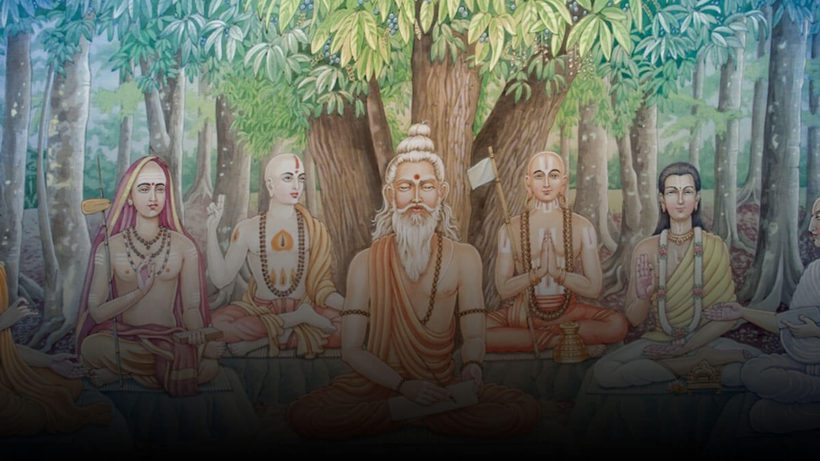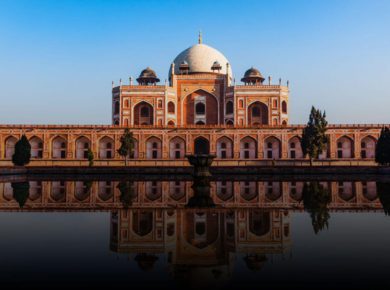Six Schools of Indian Philosophy
Vedic period defined the philosophies about true nature of soul or Atman + cosmic principle or Brahman who represented the ultimate reality. Later these philosophical concepts gave rise to six different schools of philosophies called shada darshana. They fall in the category of the orthodox system as the final authority of the Vedas is recognized by all of them.
When Varna system was well established then ancient people thought that a person should strive for:
- Artha (Economic Means) [arr] Defined in Arthashashtra of Kautilya
- Dharma (Social Order) [arr] Defined in Dharmashashtra
- Kama (Physical pleasure) [arr] Defined in Kamasutra of Vatsyanan
- Moksha (Salvation) [arr] Defined in 6 schools of Philosophy
Moksha is basically to get free from transmigration or free from cycle of birth & death
Samkhya School
- By Kapila who wrote Samkhya sutra
- Reality is constituted of two principles one female and other male i.e. Prakriti, Purusha respectively; both are completely independent & absolute
- Purusha [arr] mere consciousness, devoid of attributes, cannot be changed (absolute, independent, free, limitless)
- Prakriti [arr] constituted of materialistic attributes (thoughts & movement) + change or transformation of these attributes brings about the change in all objects.
- All in this world originates from the interplay of these two entities i.e. Purusha and Prakriti
- Later this school merged with Yoga school of Philosophy
Nyaya School
- By Gautama
- Valid knowledge is defined as the real knowledge i.e. one knows about the object as it exists viz. it is when one knows a snake as a snake or a cup as a cup;
- Basically a technique of logical thinking
- Salvation can be achieved through acquisition of knowledge & veracity of a statement can be tested via inference, hearing & analogy
- Theory of Praman – Nyaya (science of reasoning, debate, logic & epistemology)
- Pratyaksha (Perception)
- Anumana (Inference)
- Upamana(Comparison)
- Sabda (Testimony)
Yoga School
- By Patanjali who wrote Yogasutra
- Yogic techniques control body, mind & sense organs, thus considered as a means of achieving freedom or mukti
- By purifying & controlling changes in the mental mechanism, yoga systematically brings about the release of purusha from prakriti; which could be attained by practising :
- Self-control (yama) & Observation of rules (niyama)
- fixed postures (asana) & Breath control (pranayama)
- Choosing an object (pratyahara) & fixing the mind (dharna)
- Concentrating on the chosen object (dhyana)
- Complete dissolution of self, merging the mind and the object (Samadhi)
Vaisheshika School
- By Kanada
- All objects in the universe are composed of five elements–earth, water, air, fire & ether except time, space, mind & soul & God is the guiding principle
- Living beings were rewarded or punished according to the law of karma, based on actions of merit and demerit.
- Creation and destruction of universe is a cyclic process and take place in agreement with God’s wish
- Marked the beginning of physics in India & explained the phenomena of formation of universe by the atomic theory viz. Combination of atoms and molecules into matter
- Finally this school was merged with Nyaya school of philosophy
Mimamsa School
- By Jamini
- Analysis & interpretation of application & use of Samhita and Brahmana portions of the Veda
- Reasoning was used to provide justification of vedic rituals & attainment of salvation, dependent on their way of performance
- Vedas are eternal & possess all knowledge, and religion means the fulfilment of duties prescribed by the Vedas
- Vedas contains eternal truth & in order to attain salvation it strongly recommended vedic sacrifices (Which ultimately needed Brahamanas)
- Principle aim of this philosophy was to attain Heaven & salvation ( A person will enjoy heavon as long as his virtues last & then will come to earth, but in salvation he will be free from the cycle of Death & Birth)
- The names associated with this philosophy are Sabar Swami and Kumarila Bhatta.
Vedanta School
- Brahamasutra of Badrayana (200 B.C.) formed its basic structure on which commentaries were written later by Shankaracharya (900 AD) & Ramanujam (1200 AD).
- Vedanta implies the philosophy of the Upanishad, the concluding portion of the Vedas.
- Brahman is true, the world is false and self and Brahman are not different with Brahmana existent, unchanging, the highest truth and the ultimate knowledge.
- The core message of Vedanta is that every action must be governed by the intellect – the discriminating faculty. The mind makes mistakes but the intellect tells us if the action is in our interest or not.
- Vedanta enables the practitioner to access the realm of spirit through the intellect. Whether one moves into spirituality through Yoga, meditation or devotion, it must ultimately crystallize into inner understanding for attitudinal changes and enlightenment.
- Also linked with Theory of Karma e. in present birth, a person has to bear consequences of previous birth
Unorthodox School – Charvaka School
- It finds mention in the Vedas and Brihad-aranyka Upanishad, Thus, it is supposed to be the earliest in the growth of the philosophical knowledge.
- Knowledge is the product of the combination of four elements which leaves no trace after death.
- Out of the five elements earth, water, fire, air and ether, the Charvakas do not recognize ether as it is not known through perception
- Charvaka philosophy deals with the materialistic philosophy + also known as the Lokayata Philosophy – the philosophy of the masses.
- According to Charvaka there is no other world. Hence, death is the end of humans & pleasures the ultimate object in life. Charvaka recognizes no existence other than this material world.
- Charvaka denied the presence of any divinity or supernatural agency (God, soul, & heaven) & accepted only reality of existence as things exist & which can be experienced by human senses. According to him Brahamanas manufactured rituals to acquire gifts (Dakshina)
- Samkhya & vaisheshika system also propagated materialistic view of life
- Materialistic views of life also appears in doctrines of Ajivikas ( a heterodox sect of Buddhism)
Philosophy in Medieval India
Shankaracharya
- Propagated Advaita (non-dualism or belief in one reality)
- Ultimate reality is one, it being the Brahman : existent, unchanging, the highest truth & the ultimate knowledge
- World is false and self and Brahman are not different – All is Brahman and Brahman is all
Ramanujacharya
- Propagated Vishistadvaita means modified monism
- Ultimate reality is Brahman (God) & matter and soul are his qualities
Srikanthacharya
- Propagated Sivadvaita
- Ultimate Brahman is Shiva, endowed with Shakti
- Shiva exists in this world as well as beyond it
Madhavacharya
- Propagated Dvaita (Dualism)
- world is not an illusion but a reality full of differences
Nimbaraka
- Propagated Dvaitadvaita (Dualistic monism)
- God transformed himself into world and soul
- world and soul are different from God (Brahman) & survive with the support of God only, hence, they are separate but dependent
Vallabhacharya
- Propagated Suddhadvaita (Pure non-dualism)
- Brahman (God) is Sri Krishna who manifested himself as souls & matter
- God and soul are not distinct, but one
- His philosophy came to be known as Pushtimarga (the path of grace) & school was called Rudrasampradaya










